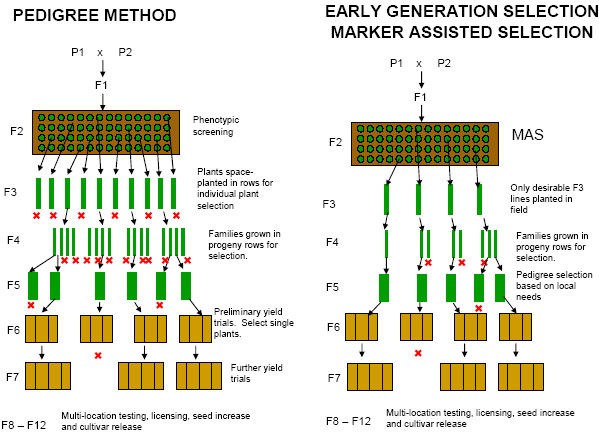February 16, 2015 – For those who fear genetically modified foods, or GMOs, there is another technology known as marker-assisted breeding that uses genome investigation to help us make the foods we grow better.
Whereas GMOs are created by inserting new genetic information into a plant genome, marker-assisted or molecular-assisted breeding tracks desirable traits in plants at the DNA level. The identified genetic markers associated with better flavour, durability, firmness, and other desirable crop characteristics can be selected so that only the seeds of these plants are bred and harvested.
Traditional selective breeding or what is known as the pedigree method, is really hit and miss. Agriculturists select seeds from plants that exhibit the best traits and hope they can reproduce the same result in subsequent generations. Sometimes two plants with different characteristics from within the same species are cross-bred to see if the descendants produce a desired end result. The process is laborious and can take decades to produce the ultimate tomato that is both tasty and firm.
The GMO process, on the other hand, is about gene alteration through a snip, cut and insert process at the molecular level. The companies that create GMOs have tended to focus on staples like wheat, corn, canola, soybeans and rice. That’s because these are the crops of modern industrial, large-scale farming. That’s where most of the money can be made.
You don’t see these companies investing in GMO bananas, pears, peaches or apples, although the United States just approved the first GMO-version of the latter, a Canadian-developed apple that when cut never browns. But they are interested in marker-assisted breeding with Monsanto seeing this technology as a viable method for improving fruits and vegetables without getting further mired in GMO controversy.
Monsanto starts with a plant seeds. Thousands of seeds are given a shave to remove a tiny amount for DNA analysis. These seeds remain viable and are planted. But the DNA of each seed is analyzed with flourescent tags attached to individual genes. The goal – to identify the plants with the best genes responsible for flavour, colour, shape and nutritional value. Where the pedigree method can take up to twenty years to produce a new desirable plant variant, using marker-assisted breeding can shorten the time by half.
For those of us who love tomatoes and are subjected to purchasing durable but tasteless produce at supermarkets, organic or otherwise, marker-assisted selection promises to end our suffering. University of Florida recently introduced two tomato hybrids, Garden Gem and Garden Treasure, both developed for quality flavour and durability. The university plans to license the seed to companies for mass distribution.
Broccoli is undergoing a similar improvement with marker-assisted selection creating larger flowering heads that don’t wilt in summer heat and provide a better taste experience. And broccoli is also being bred to raise levels of glucoraphanin, a chemical that shows promise in fighting bacterial infection and cancer.
For those who fear “Frankenfoods,” take heart, marker-assisted-bred produce can be found in Whole Food Market stores. Now you can’t get more wholesome than being accepted by the accepted leading retailer of organic produce in North America.
















